外研版(2019)必修 第一册Unit 6 At one with nature Starting out& Understanding ideas课件(共58张PPT)
文档属性
| 名称 | 外研版(2019)必修 第一册Unit 6 At one with nature Starting out& Understanding ideas课件(共58张PPT) | 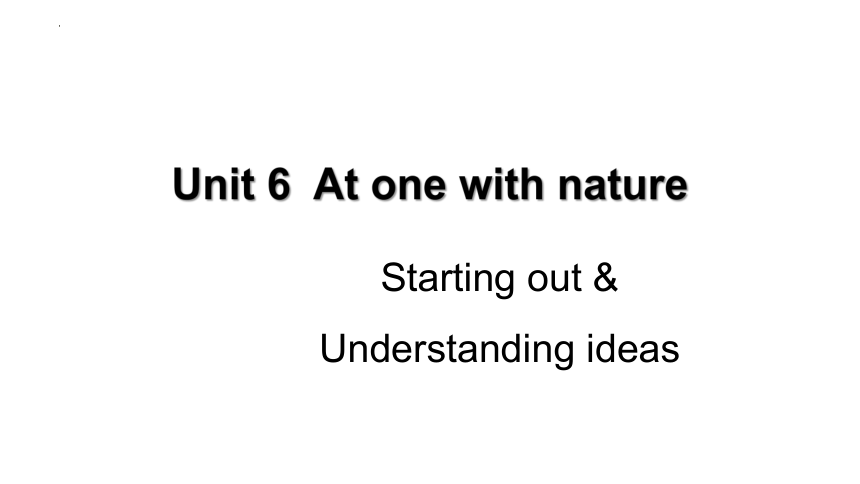 | |
| 格式 | pptx | ||
| 文件大小 | 4.2MB | ||
| 资源类型 | 教案 | ||
| 版本资源 | 外研版(2019) | ||
| 科目 | 英语 | ||
| 更新时间 | 2023-06-10 09:48:30 | ||
图片预览

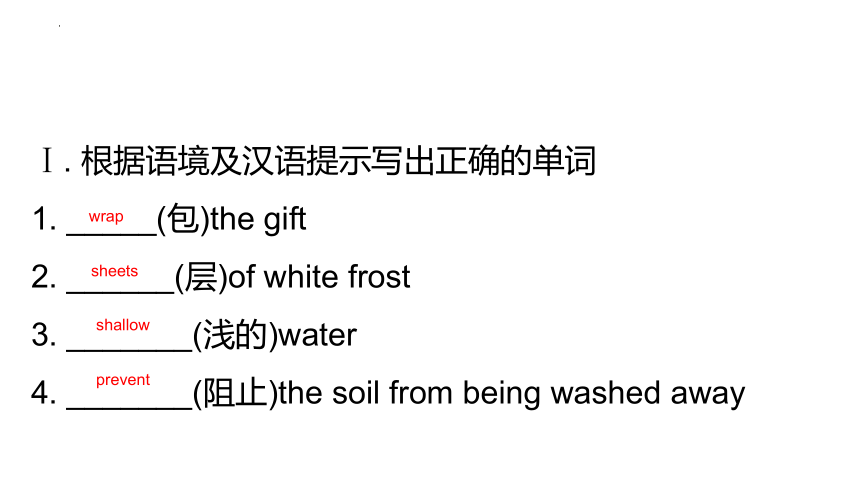
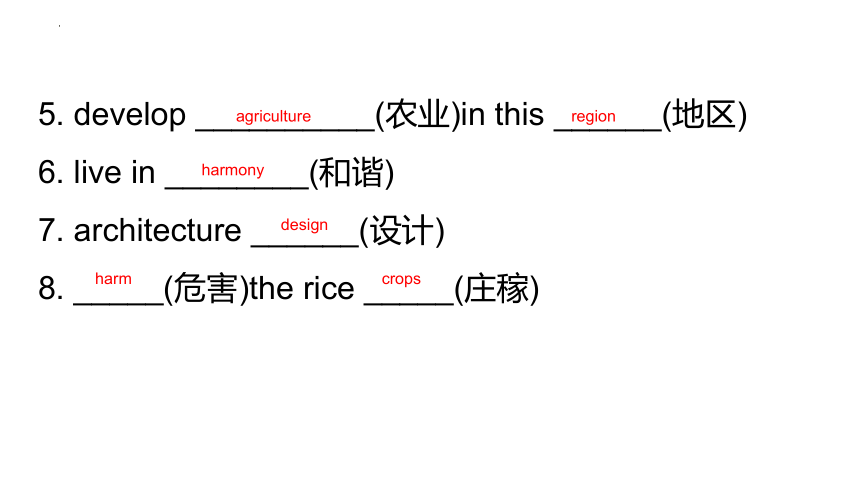
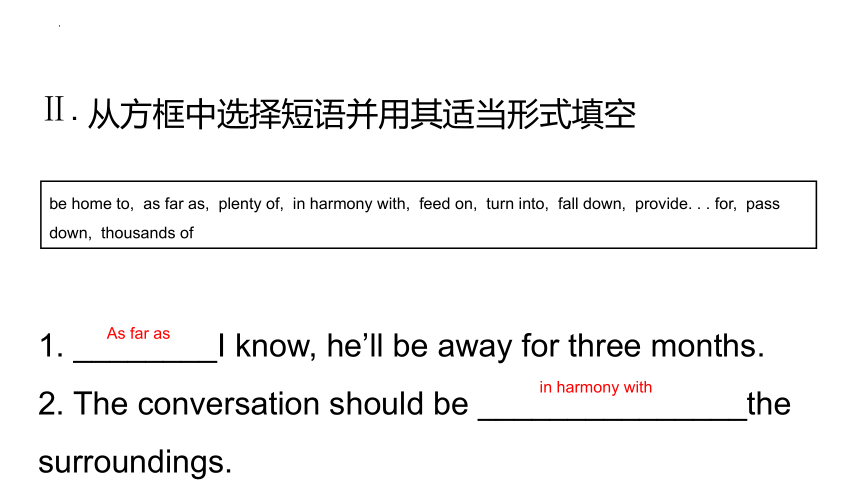
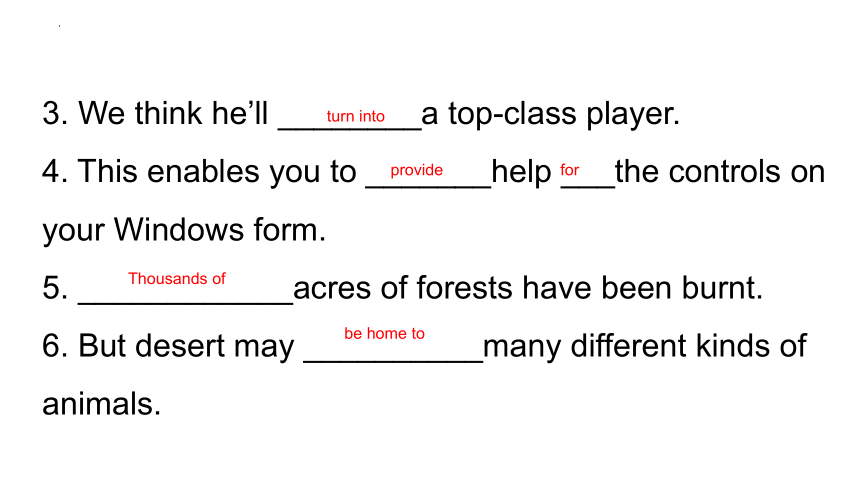
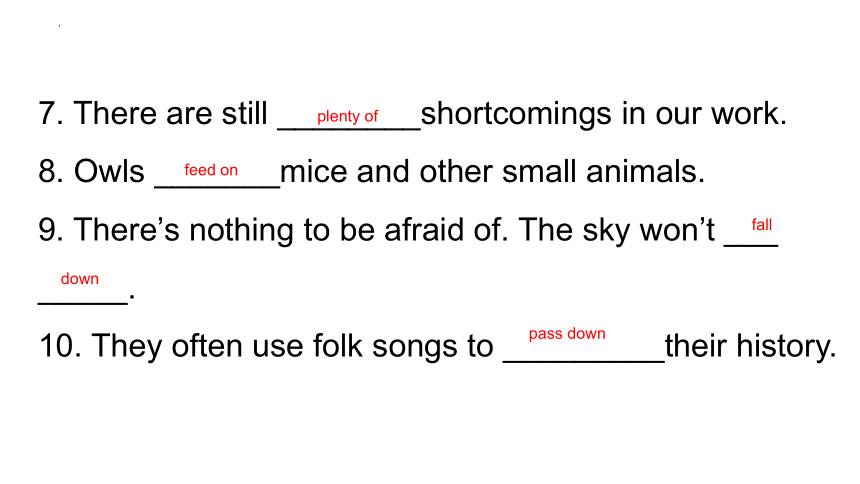

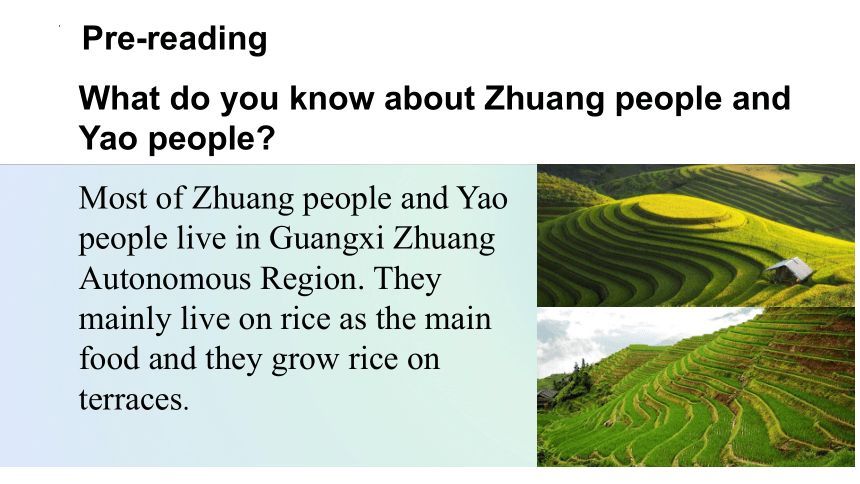
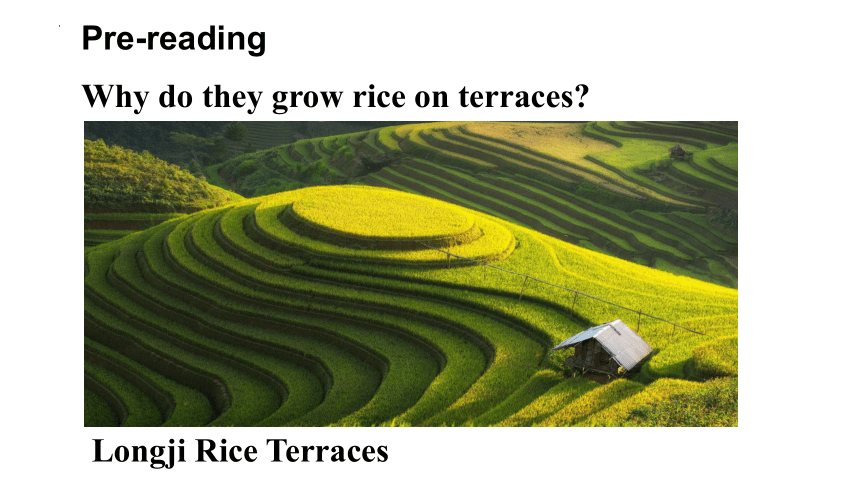
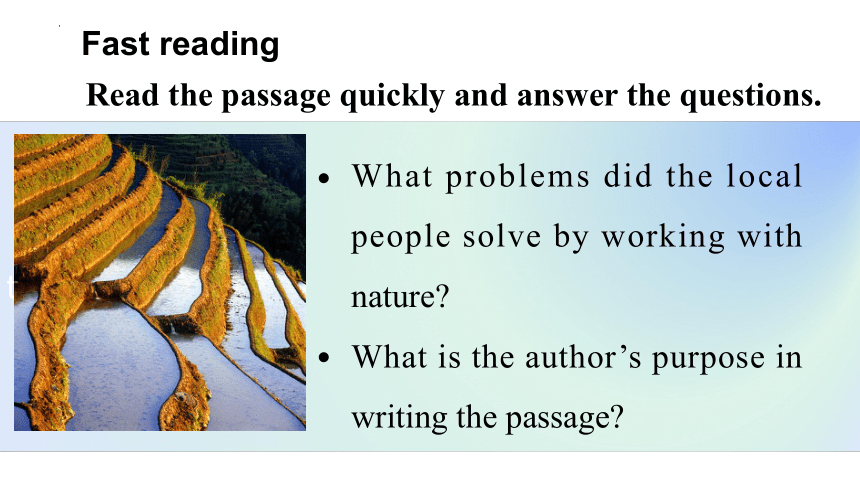
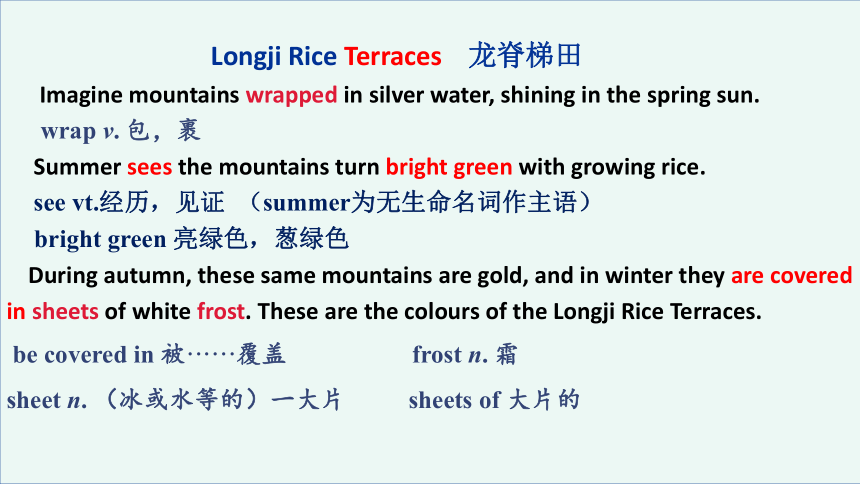
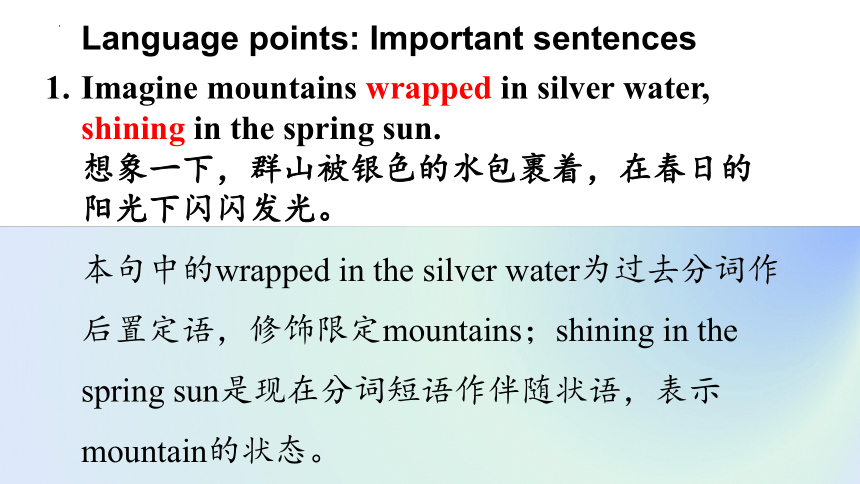
文档简介
(共58张PPT)
Unit 6 At one with nature
Starting out & Understanding ideas
Ⅰ. 根据语境及汉语提示写出正确的单词
1. _____(包)the gift
2. ______(层)of white frost
3. _______(浅的)water
4. _______(阻止)the soil from being washed away
wrap
sheets
shallow
prevent
5. develop __________(农业)in this ______(地区)
6. live in ________(和谐)
7. architecture ______(设计)
8. _____(危害)the rice _____(庄稼)
agriculture
region
harmony
design
harm
crops
Ⅱ. 从方框中选择短语并用其适当形式填空
1. ________I know, he’ll be away for three months.
2. The conversation should be _______________the
surroundings.
be home to, as far as, plenty of, in harmony with, feed on, turn into, fall down, provide. . . for, pass down, thousands of
As far as
in harmony with
3. We think he’ll ________a top-class player.
4. This enables you to _______help ___the controls on
your Windows form.
5. ____________acres of forests have been burnt.
6. But desert may __________many different kinds of
animals.
turn into
provide
for
Thousands of
be home to
7. There are still ________shortcomings in our work.
8. Owls _______mice and other small animals.
9. There’s nothing to be afraid of. The sky won’t ___
_____.
10. They often use folk songs to _________their history.
plenty of
feed on
fall
down
pass down
Pre-reading
Which ethnic group do they belong to
Zhuang people
Yao people
Most of Zhuang people and Yao people live in Guangxi Zhuang Autonomous Region. They mainly live on rice as the main food and they grow rice on terraces.
Pre-reading
What do you know about Zhuang people and Yao people
Pre-reading
Longji Rice Terraces
Why do they grow rice on terraces
t
Fast reading
Read the passage quickly and answer the questions.
What problems did the local people solve by working with nature
What is the author’s purpose in writing the passage
●
●
Longji Rice Terraces 龙脊梯田
Imagine mountains wrapped in silver water, shining in the spring sun.
wrap v. 包,裹
Summer sees the mountains turn bright green with growing rice.
see vt.经历,见证 (summer为无生命名词作主语)
bright green 亮绿色,葱绿色
During autumn, these same mountains are gold, and in winter they are covered in sheets of white frost. These are the colours of the Longji Rice Terraces.
be covered in 被······覆盖 frost n. 霜
sheet n. (冰或水等的)一大片 sheets of 大片的
Imagine mountains wrapped in silver water, shining in the spring sun.
Language points: Important sentences
本句中的wrapped in the silver water为过去分词作后置定语,修饰限定mountains;shining in the spring sun是现在分词短语作伴随状语,表示mountain的状态。
想象一下,群山被银色的水包裹着,在春日的阳光下闪闪发光。
1.
想象一下:春日,群山被银白色的水包裹着,在阳光下闪闪发光;盛夏,佳禾吐绿,将群山染成一片青翠。秋收,满山黄金,而隆冬,它们又披上了冰霜做成的雪白毛毯。这,就是绚丽多彩的龙脊梯田。
These terraces were built by the local Zhuang and Yao people, to whom Guangxi is home.
be home to是······的家园/故乡
Starting in the Yuan Dynasty, work on the terraces took hundreds of years, until its completion in the early Qing Dynasty.
dynasty n. 朝代 completion n. 完成,结束
Reaching as far as the eye can see, these terraces cover tall mountains, often from the bottom to the very top.
as far as the eye can see极目所尽, 目之所及
from the bottom to the very top 从底部到顶部
此处为“介词+关系代词”引导的定语从句。
在本句话中, reaching as far as the eye can see为现在分词作状语,逻辑主语为句子主语 these terraces。as far as the eye can see意为 “目之所及”, from the bottom to the top意为“从山脚到山顶”。
Reaching as far as the eye can see, these terraces cover tall mountains, often from the bottom to the top.
Language points: Important sentences
放眼望去,这些梯田覆盖着高山,通常从山底一直延伸到山顶。
2.
龙脊梯田的建造者是广西当地的壮族和瑶族居民。梯田从元朝开始修建,历经数百年,直到清初才完工。目之所及,梯田包裹着巍峨的高山,往往从山脚一直盘绕到山顶。
So why did these people go to so much trouble to turn the entire mountains into terraces
go to the trouble to do...不辞辛劳做某事
turn...into...把······变成······
Firstly, there are few large, flat areas of land in the region.
Firstly...Secondly...首先······其次······(用于说明顺序)
flat areas of land 平坦地区,平原 region n.地区,区域
Building the terraces therefore meant (that they could increase the areas in which they could grow rice. )
therefore/' e fo:/adv.因此,由此
动名词短语作主语
in which 引导的定语从句修饰 the areas
为什么当地人要如此大费周章,把整片山区变成梯田呢?首先,这里缺乏大面积的平原,建造梯田意味着他们可以扩大水稻的种植面积。
Secondly, although the region has plenty of rain, the mountains are steep and the soil is shallow. The flat terraces catch the rainwater and prevent the soil from being washed away.
plenty of 大量的(修饰不可数名词或可数名词复数)
steep/sti:p/adj.陡的,陡峭的
soil/soil/n.土壤 shallow/'f l u/adj.浅的
prevent/pri'vent/v.阻挡,防止
prevent...from doing sth. 阻止····· 做某事
wash...away 把······冲走
其次,尽管该地区雨水充沛,但山地坡度大,土层浅薄。水平的梯田能够储存雨水,防止土壤被冲走。
1. prevent sb/ sth (from) doing sth阻止某人/某物做某事
·The flat terraces catch the rainwater and prevent the soil from being washed away.
(教材P63)平坦的梯田吸收雨水并且防止土壤被冲走。
单句语法填空
①What was it that prevented Ben ____________ coming in time
from
补全句子
②The heavy rain _________________________________ on time.
大雨使得他没能按时到达那里。
③We try to make a fire to ___________________________________.
我们试图生火保护我们免受夜晚的寒冷。
prevented him arriving there
protect us from the cold night
短语记牢
(1) prevent sb/ sth (from) doing sth=stop sb/ sth (from) (doing) sth=keep sb/ sth from doing sth阻止某人/某物做某事
(2) protect...from/ against... 保护……免受……的侵害
名师提醒
prevent sb/ sth (from) (doing) sth和stop sb/ sth (from) (doing) sth用法相同,在主动语态中from可以省略,但是在被动语态中from不能省略。
But perhaps what is most significant is the way in which people have worked in harmony with nature to make these terraces and grow rice.
significant adj.重要的,影响深远的
harmony/'ha:m ni/n.融洽相处, 和谐
*in harmony with 与······协调, 与······一致
work/live in harmony with 与······愉快共事/和谐生活
The terraces are cleverly designed, with hundreds of waterways that connect with each other. During the rainy season, it is along these waterways that rainwater moves down the mountains and into the terraces.
design v. 设计 be cleverly designed 设计巧妙
in which 引导定语从句,修饰the way. 其中which 指代the way, 表示“劳作的方式、方法”
单词一族
harmonious adj. 和谐的,协调的
用法总结
in harmony with 与……融洽;与……一致
out of harmony with 与……不协调,不一致
2. harmony n. 融洽相处,和谐
3. design vt. 设计;打算;意欲,意图n. 设计;图案
·The terraces are cleverly designed, with hundreds of waterways that connect with each other. (教材P63)梯田设计巧妙,数百条水道相互连通。
·The weekend party was designed to bring the two old men together.
这次周末聚会的用意是让两位老人见面。
·It is designed as a textbook for a one-term course. 它可用作一学期课程的教材。
单句语法填空
①This entrance has been specially designed ____________ people in wheelchairs.
②We don' t know whether it was done by accident or ____________ design.
③This is a very beautiful house, ____________ (design) for his parents.
for
by
designed
单词一族
designer n. 设计者;设计师
用法总结
design sth.for sb. 为某人设计某物
be designed for 为······而设计/准备
be designed to do sth. 为做某事而设计;目的是做某事
by design(=on purpose)故意地
强调句型基本结构:It is / was + 被强调部分 + that +其他成分,用来强调谓语动词外的其它句子成分。原则上说,若将其去掉,句子意思依然清楚,结构仍然完整。被强调的部分指的是人时,句型中的that可以用who替换。
During the rainy season, it is along these waterways that rainwater moves down the mountains and into the terraces.
Language points: Important sentences
在多雨季节,雨水正是沿着沟渠流下山,流到梯田中。
3.
但也许最令人惊叹的还是人们与自然和谐相处建造梯田和种植水稻的方式。梯田设计巧妙,其间有数百条相互连接的水渠。在雨季,雨水会沿着这些水渠从山上流入梯田。
The sun heats the water and turns it into vapour. vapour n.蒸气
This forms clouds from which rain falls down onto the mountain terraces once again. These terraces also provide a perfect environment for birds and fish, some of which feed on insects that can harm the rice crops.
fall down onto 降落到······上 once again 再次
provide sth.for sb.为某人提供某物
feed on(动物)以······为食
harm/ha:m/v.伤害,损害 n. U 伤害,损害
*do harm to 对······造成伤害 crop/krpp/n.庄稼,作物
4. provide sth. for sb.
为某人提供某物
provide sb. with sth.
provide sth.for sb.
·supply 尤指大量供应、供给
supply sb. with sth.
supply sth. to sb.
·offer强调主动提供
offer sb.sth.
offer sth. to sb.
单词一族
harmful adj. 有害的;伤害的
harmless adj. 无害的
用法总结
do...harm/ do harm to... 对……有害
There is no harm in doing sth 做某事无害处
be harmful to ... 对……有害处
be harmless to... 对.....无害
3. harm vt. & n. 伤害,损害
水分经太阳蒸发成水蒸气,水蒸气形成云,而雨水又从云中再次落到山上的梯田里。这些梯田还为鸟类和鱼类提供了绝佳的栖息地,而一部分鸟和鱼又以危害水稻作物的昆虫为食。
Although modern technology could help produce more crops, these terraces still mean a lot to the people for whom traditions hold much value.
mean a lot to 对······意义重大 hold much value十分重要,有价值
This knowledge is passed down through families, which means that new generations
pass...down 把······往下传 generation n.一代人
continue to use ancient methods of agriculture to maintain the terraces.
agriculture/' gri,kaltf /n.农业
*ancient methods of agriculture 古老的农耕方式
Today, the Longji Rice Terraces attract thousands of visitors who come to admire this great wonder created by people and nature working together.
尽管现代技术可以帮助提高农作物产量,但这些梯田对珍视传统的当地人来说仍然意义重大。这种知识通过家庭代代相传,后代子孙一直沿用古老的农耕方法来维持着梯田的运作。今天,成千上万的游客慕名前来欣赏这由人与自然共同创造的壮丽奇观。
4. attract v. 吸引,引起……的兴趣
·Today, the Longji Rice Terraces attract thousands of visitors who come to admire this great wonder created by people and nature working together. (教材P63)今天龙脊梯田吸引了成千上万的游客来欣赏这个由人和大自然共同创造的伟大奇迹。
·I was doubly attracted to the house, by its size and its location.
我喜欢这房子有两方面的原因,大小合适而且位置也好。
·I tried to attract his attention, but he was still lost in thought.
我试图吸引他的注意力,但是他仍然陷入沉思。
·China is attractive to tourists for its beautiful scenery and historic sites.
中国的风景名胜和历史古迹对旅游者很有吸引力。
用attract的适当形式填空
①I wish his words ____________ the audience.
②This new iPad is more ____________ than any other one.
③Beijing is also a tourist ____________.
补全句子
④WTO membership made China ______________________________ foreign investors.
加入WTO使中国对于外国投资者更具吸引力。
to attract
attractive
attraction
even more attractive to
单词一族
attractive adj. 吸引人的
attraction n. 吸引;吸引人的事物;吸引力
用法总结
(1) attract sb to sb/ sth 引起某人对某人/某物的注意
attract one' s attention 吸引某人的注意
(2) be attractive to... 对……有吸引力
a tourist attraction 旅游胜地
Ⅰ. 文本整体理解: 理清文章架构
Ⅱ. 文本细节理解: 探寻语篇细节信息
1. Which of the following descriptions is not right according to Paragraph 1
A. Green spring. B. Bright summer.
C. Gold autumn. D. White winter.
2. Which is not true about the terrace according to Paragraph 2
A. It was built by the Zhuang and Yao people.
B. It was built from the Yuan Dynasty.
C. Its construction only lasted two dynasties.
D. It was completed in the Qing Dynasty.
3. Which of the following is not the reason for building the terraces
A. There are few large, flat areas of land.
B. They could increase the rice growing area.
C. The region has plenty of water and the mountains are steep.
D. The terrace can prevent the soil from being washed away.
4. Which word can be used to describe the relationship of the terrace and the people
A. Significant. B. Harmonious.
C. Clever. D. Harmful.
5. What is the main idea of Paragraph 5
A. Modern technology could help produce more crops.
B. The traditions hold much value for the people.
C. New generations continue to maintain the terraces.
D. Today’s Longji Rice Terraces.
6. The passage may appear in a .
A. journal B. travel guide
C. popular magazine D. storybook
答案: 1~6. ACCBDB
Ⅲ. 文本素养提升: 阅读技能综合运用
1. 根据课文语境与语句知识细致解构语句。
译文: 因此, _________意味着他们可以增加_______
_________。
建造梯田
种植水
稻的区域
2. 根据课文完成短文。
The colours of the Longji Rice Terraces are
different from season to season. These terraces were
(1) _____(build) by the local people in Guangxi.
(2)________(start) in the Yuan Dynasty, work on the
terraces (3)____(take) hundreds of years. Building the
terraces meant (4)____ they could increase the areas
built
Starting
took
that
(5)__ which they could grow rice. The flat terraces can
prevent the soil (6) _____ being washed away.
Nowadays, people work in harmony with nature to
make these terraces (7)____ grow rice. These terraces
also provide a perfect environment for birds and (8)
____(fish). (9)_________ modern technology could help produce more crops, new generations continue
in
from
and
fish
Although
to use ancient (10) ________(method) to maintain the terraces.
methods
【阅读微技巧】
在阅读的过程中关注具有多种词性的单词所在的语境, 更利于理解 1. 阅读中的难点可能是一个句子, 但也可能是某个单词。
2. 某些常见单词的含义或者用法可能会因为语境的不同发生变化, 如 The sun heats the water. 中heat就是作为动词来使用的。
Fast reading
Read the passage quickly and answer the questions.
Two problems are solved. The first one is that there are few large, flat areas of land in the region for people to grow rice. The other one is that the mountains are steep and the soil is shallow.
What problems did the local people solve by working with nature
1.
Fast reading
Read the passage quickly and answer the questions.
2. What is the author’s purpose in writing the passage
To praise the wisdom of the ethnic groups living in Guangxi Zhuang Autonomous Region.
To explain how people worked in harmony with nature to create the Longji Rice Terraces.
To describe the beauty of the Longji Rice Terraces and attract visitors to this scenic spot.
Fast reading: Reading strategy
Decide what kind of article the passage is — narrative,
argumentation, or expository, etc.
Work out the structure of the passage.
Find the topic sentence and key words of each paragraph.
Summarize these sentences and get the main idea
of the passage.
How to read for the main idea and the author’s purpose
1.
2.
3.
4.
Intensive reading
The Longji Rice Terraces were built by the local Zhuang ethnic group alone. Though there are many large, flat areas in the region, they built terraces on the mountains to have more areas to grow rice. The terraces are cleverly designed, and can wash away the shallow soil. There are hundreds of waterways, along which rainwater moves down the mountains and into the terraces. Today, local people use modern methods to maintain the terraces, and they attract lots of visitors from all over the world.
Read the passage carefully and then correct four factual mistakes in the summary.
Intensive reading
The Longji Rice Terraces were built by the local Zhuang and Yao people. Since there are few large, flat areas in the region, they built terraces on the mountains to have more areas to grow rice. The terraces are cleverly designed, and can hold the shallow soil. There are hundreds of waterways, along which rainwater moves down the mountains and into the terraces. Today, local people use ancient methods of agriculture to maintain the terraces, and they attract lots of visitors from all over the world.
Read the passage carefully and then correct four factual mistakes in the summary.
Intensive reading
Read the passage again and find out the working principle of the Longji Rice Terraces.
rain
sun
vapor
Intensive reading
Retell the working principle of the Longji Rice Terraces.
rain
sun
vapor
Intensive reading
Retell the working principle of the Longji Rice Terraces.
During the rainy season, rainwater moves down the mountains along hundreds of waterways that connect with each other and the terraces. The sun heats the water and turns it into vapor. This forms clouds, from which rain falls down onto the mountain terraces once again.
Post-reading: Think and share
Why do the local people still keep their traditional way of growing rice?
In what other ways do people live in harmony with nature Give examples.
Discuss in groups about the following questions.
1.
2.
Unit 6 At one with nature
Starting out & Understanding ideas
Ⅰ. 根据语境及汉语提示写出正确的单词
1. _____(包)the gift
2. ______(层)of white frost
3. _______(浅的)water
4. _______(阻止)the soil from being washed away
wrap
sheets
shallow
prevent
5. develop __________(农业)in this ______(地区)
6. live in ________(和谐)
7. architecture ______(设计)
8. _____(危害)the rice _____(庄稼)
agriculture
region
harmony
design
harm
crops
Ⅱ. 从方框中选择短语并用其适当形式填空
1. ________I know, he’ll be away for three months.
2. The conversation should be _______________the
surroundings.
be home to, as far as, plenty of, in harmony with, feed on, turn into, fall down, provide. . . for, pass down, thousands of
As far as
in harmony with
3. We think he’ll ________a top-class player.
4. This enables you to _______help ___the controls on
your Windows form.
5. ____________acres of forests have been burnt.
6. But desert may __________many different kinds of
animals.
turn into
provide
for
Thousands of
be home to
7. There are still ________shortcomings in our work.
8. Owls _______mice and other small animals.
9. There’s nothing to be afraid of. The sky won’t ___
_____.
10. They often use folk songs to _________their history.
plenty of
feed on
fall
down
pass down
Pre-reading
Which ethnic group do they belong to
Zhuang people
Yao people
Most of Zhuang people and Yao people live in Guangxi Zhuang Autonomous Region. They mainly live on rice as the main food and they grow rice on terraces.
Pre-reading
What do you know about Zhuang people and Yao people
Pre-reading
Longji Rice Terraces
Why do they grow rice on terraces
t
Fast reading
Read the passage quickly and answer the questions.
What problems did the local people solve by working with nature
What is the author’s purpose in writing the passage
●
●
Longji Rice Terraces 龙脊梯田
Imagine mountains wrapped in silver water, shining in the spring sun.
wrap v. 包,裹
Summer sees the mountains turn bright green with growing rice.
see vt.经历,见证 (summer为无生命名词作主语)
bright green 亮绿色,葱绿色
During autumn, these same mountains are gold, and in winter they are covered in sheets of white frost. These are the colours of the Longji Rice Terraces.
be covered in 被······覆盖 frost n. 霜
sheet n. (冰或水等的)一大片 sheets of 大片的
Imagine mountains wrapped in silver water, shining in the spring sun.
Language points: Important sentences
本句中的wrapped in the silver water为过去分词作后置定语,修饰限定mountains;shining in the spring sun是现在分词短语作伴随状语,表示mountain的状态。
想象一下,群山被银色的水包裹着,在春日的阳光下闪闪发光。
1.
想象一下:春日,群山被银白色的水包裹着,在阳光下闪闪发光;盛夏,佳禾吐绿,将群山染成一片青翠。秋收,满山黄金,而隆冬,它们又披上了冰霜做成的雪白毛毯。这,就是绚丽多彩的龙脊梯田。
These terraces were built by the local Zhuang and Yao people, to whom Guangxi is home.
be home to是······的家园/故乡
Starting in the Yuan Dynasty, work on the terraces took hundreds of years, until its completion in the early Qing Dynasty.
dynasty n. 朝代 completion n. 完成,结束
Reaching as far as the eye can see, these terraces cover tall mountains, often from the bottom to the very top.
as far as the eye can see极目所尽, 目之所及
from the bottom to the very top 从底部到顶部
此处为“介词+关系代词”引导的定语从句。
在本句话中, reaching as far as the eye can see为现在分词作状语,逻辑主语为句子主语 these terraces。as far as the eye can see意为 “目之所及”, from the bottom to the top意为“从山脚到山顶”。
Reaching as far as the eye can see, these terraces cover tall mountains, often from the bottom to the top.
Language points: Important sentences
放眼望去,这些梯田覆盖着高山,通常从山底一直延伸到山顶。
2.
龙脊梯田的建造者是广西当地的壮族和瑶族居民。梯田从元朝开始修建,历经数百年,直到清初才完工。目之所及,梯田包裹着巍峨的高山,往往从山脚一直盘绕到山顶。
So why did these people go to so much trouble to turn the entire mountains into terraces
go to the trouble to do...不辞辛劳做某事
turn...into...把······变成······
Firstly, there are few large, flat areas of land in the region.
Firstly...Secondly...首先······其次······(用于说明顺序)
flat areas of land 平坦地区,平原 region n.地区,区域
Building the terraces therefore meant (that they could increase the areas in which they could grow rice. )
therefore/' e fo:/adv.因此,由此
动名词短语作主语
in which 引导的定语从句修饰 the areas
为什么当地人要如此大费周章,把整片山区变成梯田呢?首先,这里缺乏大面积的平原,建造梯田意味着他们可以扩大水稻的种植面积。
Secondly, although the region has plenty of rain, the mountains are steep and the soil is shallow. The flat terraces catch the rainwater and prevent the soil from being washed away.
plenty of 大量的(修饰不可数名词或可数名词复数)
steep/sti:p/adj.陡的,陡峭的
soil/soil/n.土壤 shallow/'f l u/adj.浅的
prevent/pri'vent/v.阻挡,防止
prevent...from doing sth. 阻止····· 做某事
wash...away 把······冲走
其次,尽管该地区雨水充沛,但山地坡度大,土层浅薄。水平的梯田能够储存雨水,防止土壤被冲走。
1. prevent sb/ sth (from) doing sth阻止某人/某物做某事
·The flat terraces catch the rainwater and prevent the soil from being washed away.
(教材P63)平坦的梯田吸收雨水并且防止土壤被冲走。
单句语法填空
①What was it that prevented Ben ____________ coming in time
from
补全句子
②The heavy rain _________________________________ on time.
大雨使得他没能按时到达那里。
③We try to make a fire to ___________________________________.
我们试图生火保护我们免受夜晚的寒冷。
prevented him arriving there
protect us from the cold night
短语记牢
(1) prevent sb/ sth (from) doing sth=stop sb/ sth (from) (doing) sth=keep sb/ sth from doing sth阻止某人/某物做某事
(2) protect...from/ against... 保护……免受……的侵害
名师提醒
prevent sb/ sth (from) (doing) sth和stop sb/ sth (from) (doing) sth用法相同,在主动语态中from可以省略,但是在被动语态中from不能省略。
But perhaps what is most significant is the way in which people have worked in harmony with nature to make these terraces and grow rice.
significant adj.重要的,影响深远的
harmony/'ha:m ni/n.融洽相处, 和谐
*in harmony with 与······协调, 与······一致
work/live in harmony with 与······愉快共事/和谐生活
The terraces are cleverly designed, with hundreds of waterways that connect with each other. During the rainy season, it is along these waterways that rainwater moves down the mountains and into the terraces.
design v. 设计 be cleverly designed 设计巧妙
in which 引导定语从句,修饰the way. 其中which 指代the way, 表示“劳作的方式、方法”
单词一族
harmonious adj. 和谐的,协调的
用法总结
in harmony with 与……融洽;与……一致
out of harmony with 与……不协调,不一致
2. harmony n. 融洽相处,和谐
3. design vt. 设计;打算;意欲,意图n. 设计;图案
·The terraces are cleverly designed, with hundreds of waterways that connect with each other. (教材P63)梯田设计巧妙,数百条水道相互连通。
·The weekend party was designed to bring the two old men together.
这次周末聚会的用意是让两位老人见面。
·It is designed as a textbook for a one-term course. 它可用作一学期课程的教材。
单句语法填空
①This entrance has been specially designed ____________ people in wheelchairs.
②We don' t know whether it was done by accident or ____________ design.
③This is a very beautiful house, ____________ (design) for his parents.
for
by
designed
单词一族
designer n. 设计者;设计师
用法总结
design sth.for sb. 为某人设计某物
be designed for 为······而设计/准备
be designed to do sth. 为做某事而设计;目的是做某事
by design(=on purpose)故意地
强调句型基本结构:It is / was + 被强调部分 + that +其他成分,用来强调谓语动词外的其它句子成分。原则上说,若将其去掉,句子意思依然清楚,结构仍然完整。被强调的部分指的是人时,句型中的that可以用who替换。
During the rainy season, it is along these waterways that rainwater moves down the mountains and into the terraces.
Language points: Important sentences
在多雨季节,雨水正是沿着沟渠流下山,流到梯田中。
3.
但也许最令人惊叹的还是人们与自然和谐相处建造梯田和种植水稻的方式。梯田设计巧妙,其间有数百条相互连接的水渠。在雨季,雨水会沿着这些水渠从山上流入梯田。
The sun heats the water and turns it into vapour. vapour n.蒸气
This forms clouds from which rain falls down onto the mountain terraces once again. These terraces also provide a perfect environment for birds and fish, some of which feed on insects that can harm the rice crops.
fall down onto 降落到······上 once again 再次
provide sth.for sb.为某人提供某物
feed on(动物)以······为食
harm/ha:m/v.伤害,损害 n. U 伤害,损害
*do harm to 对······造成伤害 crop/krpp/n.庄稼,作物
4. provide sth. for sb.
为某人提供某物
provide sb. with sth.
provide sth.for sb.
·supply 尤指大量供应、供给
supply sb. with sth.
supply sth. to sb.
·offer强调主动提供
offer sb.sth.
offer sth. to sb.
单词一族
harmful adj. 有害的;伤害的
harmless adj. 无害的
用法总结
do...harm/ do harm to... 对……有害
There is no harm in doing sth 做某事无害处
be harmful to ... 对……有害处
be harmless to... 对.....无害
3. harm vt. & n. 伤害,损害
水分经太阳蒸发成水蒸气,水蒸气形成云,而雨水又从云中再次落到山上的梯田里。这些梯田还为鸟类和鱼类提供了绝佳的栖息地,而一部分鸟和鱼又以危害水稻作物的昆虫为食。
Although modern technology could help produce more crops, these terraces still mean a lot to the people for whom traditions hold much value.
mean a lot to 对······意义重大 hold much value十分重要,有价值
This knowledge is passed down through families, which means that new generations
pass...down 把······往下传 generation n.一代人
continue to use ancient methods of agriculture to maintain the terraces.
agriculture/' gri,kaltf /n.农业
*ancient methods of agriculture 古老的农耕方式
Today, the Longji Rice Terraces attract thousands of visitors who come to admire this great wonder created by people and nature working together.
尽管现代技术可以帮助提高农作物产量,但这些梯田对珍视传统的当地人来说仍然意义重大。这种知识通过家庭代代相传,后代子孙一直沿用古老的农耕方法来维持着梯田的运作。今天,成千上万的游客慕名前来欣赏这由人与自然共同创造的壮丽奇观。
4. attract v. 吸引,引起……的兴趣
·Today, the Longji Rice Terraces attract thousands of visitors who come to admire this great wonder created by people and nature working together. (教材P63)今天龙脊梯田吸引了成千上万的游客来欣赏这个由人和大自然共同创造的伟大奇迹。
·I was doubly attracted to the house, by its size and its location.
我喜欢这房子有两方面的原因,大小合适而且位置也好。
·I tried to attract his attention, but he was still lost in thought.
我试图吸引他的注意力,但是他仍然陷入沉思。
·China is attractive to tourists for its beautiful scenery and historic sites.
中国的风景名胜和历史古迹对旅游者很有吸引力。
用attract的适当形式填空
①I wish his words ____________ the audience.
②This new iPad is more ____________ than any other one.
③Beijing is also a tourist ____________.
补全句子
④WTO membership made China ______________________________ foreign investors.
加入WTO使中国对于外国投资者更具吸引力。
to attract
attractive
attraction
even more attractive to
单词一族
attractive adj. 吸引人的
attraction n. 吸引;吸引人的事物;吸引力
用法总结
(1) attract sb to sb/ sth 引起某人对某人/某物的注意
attract one' s attention 吸引某人的注意
(2) be attractive to... 对……有吸引力
a tourist attraction 旅游胜地
Ⅰ. 文本整体理解: 理清文章架构
Ⅱ. 文本细节理解: 探寻语篇细节信息
1. Which of the following descriptions is not right according to Paragraph 1
A. Green spring. B. Bright summer.
C. Gold autumn. D. White winter.
2. Which is not true about the terrace according to Paragraph 2
A. It was built by the Zhuang and Yao people.
B. It was built from the Yuan Dynasty.
C. Its construction only lasted two dynasties.
D. It was completed in the Qing Dynasty.
3. Which of the following is not the reason for building the terraces
A. There are few large, flat areas of land.
B. They could increase the rice growing area.
C. The region has plenty of water and the mountains are steep.
D. The terrace can prevent the soil from being washed away.
4. Which word can be used to describe the relationship of the terrace and the people
A. Significant. B. Harmonious.
C. Clever. D. Harmful.
5. What is the main idea of Paragraph 5
A. Modern technology could help produce more crops.
B. The traditions hold much value for the people.
C. New generations continue to maintain the terraces.
D. Today’s Longji Rice Terraces.
6. The passage may appear in a .
A. journal B. travel guide
C. popular magazine D. storybook
答案: 1~6. ACCBDB
Ⅲ. 文本素养提升: 阅读技能综合运用
1. 根据课文语境与语句知识细致解构语句。
译文: 因此, _________意味着他们可以增加_______
_________。
建造梯田
种植水
稻的区域
2. 根据课文完成短文。
The colours of the Longji Rice Terraces are
different from season to season. These terraces were
(1) _____(build) by the local people in Guangxi.
(2)________(start) in the Yuan Dynasty, work on the
terraces (3)____(take) hundreds of years. Building the
terraces meant (4)____ they could increase the areas
built
Starting
took
that
(5)__ which they could grow rice. The flat terraces can
prevent the soil (6) _____ being washed away.
Nowadays, people work in harmony with nature to
make these terraces (7)____ grow rice. These terraces
also provide a perfect environment for birds and (8)
____(fish). (9)_________ modern technology could help produce more crops, new generations continue
in
from
and
fish
Although
to use ancient (10) ________(method) to maintain the terraces.
methods
【阅读微技巧】
在阅读的过程中关注具有多种词性的单词所在的语境, 更利于理解 1. 阅读中的难点可能是一个句子, 但也可能是某个单词。
2. 某些常见单词的含义或者用法可能会因为语境的不同发生变化, 如 The sun heats the water. 中heat就是作为动词来使用的。
Fast reading
Read the passage quickly and answer the questions.
Two problems are solved. The first one is that there are few large, flat areas of land in the region for people to grow rice. The other one is that the mountains are steep and the soil is shallow.
What problems did the local people solve by working with nature
1.
Fast reading
Read the passage quickly and answer the questions.
2. What is the author’s purpose in writing the passage
To praise the wisdom of the ethnic groups living in Guangxi Zhuang Autonomous Region.
To explain how people worked in harmony with nature to create the Longji Rice Terraces.
To describe the beauty of the Longji Rice Terraces and attract visitors to this scenic spot.
Fast reading: Reading strategy
Decide what kind of article the passage is — narrative,
argumentation, or expository, etc.
Work out the structure of the passage.
Find the topic sentence and key words of each paragraph.
Summarize these sentences and get the main idea
of the passage.
How to read for the main idea and the author’s purpose
1.
2.
3.
4.
Intensive reading
The Longji Rice Terraces were built by the local Zhuang ethnic group alone. Though there are many large, flat areas in the region, they built terraces on the mountains to have more areas to grow rice. The terraces are cleverly designed, and can wash away the shallow soil. There are hundreds of waterways, along which rainwater moves down the mountains and into the terraces. Today, local people use modern methods to maintain the terraces, and they attract lots of visitors from all over the world.
Read the passage carefully and then correct four factual mistakes in the summary.
Intensive reading
The Longji Rice Terraces were built by the local Zhuang and Yao people. Since there are few large, flat areas in the region, they built terraces on the mountains to have more areas to grow rice. The terraces are cleverly designed, and can hold the shallow soil. There are hundreds of waterways, along which rainwater moves down the mountains and into the terraces. Today, local people use ancient methods of agriculture to maintain the terraces, and they attract lots of visitors from all over the world.
Read the passage carefully and then correct four factual mistakes in the summary.
Intensive reading
Read the passage again and find out the working principle of the Longji Rice Terraces.
rain
sun
vapor
Intensive reading
Retell the working principle of the Longji Rice Terraces.
rain
sun
vapor
Intensive reading
Retell the working principle of the Longji Rice Terraces.
During the rainy season, rainwater moves down the mountains along hundreds of waterways that connect with each other and the terraces. The sun heats the water and turns it into vapor. This forms clouds, from which rain falls down onto the mountain terraces once again.
Post-reading: Think and share
Why do the local people still keep their traditional way of growing rice?
In what other ways do people live in harmony with nature Give examples.
Discuss in groups about the following questions.
1.
2.
